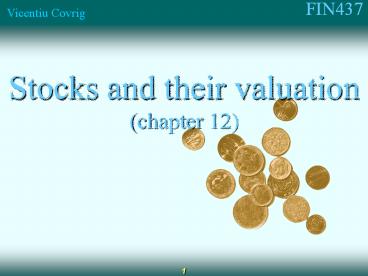Stocks and their valuation
Title:
Stocks and their valuation
Description:
Stocks and their valuation (chapter 12) Stocks and their valuation (chapter 12) Intrinsic Value and Stock Price Outside investors, corporate insiders, and analysts ... –
Number of Views:175
Avg rating:3.0/5.0
Title: Stocks and their valuation
1
- Stocks and their valuation
- (chapter 12)
2
Intrinsic Value and Stock Price
- Outside investors, corporate insiders, and
analysts use a variety of approaches to estimate
a stocks intrinsic value (P0). - In equilibrium we assume that a stocks price
equals its intrinsic value. - Outsiders estimate intrinsic value to help
determine which stocks are attractive to buy
and/or sell. - Stocks with a price below its intrinsic value are
undervalued - Buy or Sell?
- Stocks with a price above its intrinsic value are
overvalued - Buy or Sell?
3
Dividend growth model
- Value of a stock is the present value of the
future dividends expected to be generated by the
stock. - r s is the required rate of return (think the
one from CAPM)
4
Constant growth stock
- A stock whose dividends are expected to grow
forever at a constant rate, g. - D1 D0 (1g)1
- D2 D0 (1g)2
- Dt D0 (1g)t
- If g is constant, the dividend growth formula
converges to
5
What happens if g gt rs?
- If g gt rs, the constant growth formula leads to a
negative stock price, which does not make sense. - The constant growth model can only be used if
- rs gt g
- g is expected to be constant forever
6
If rRF 7, rM 12, and ß 1.2, what is the
required rate of return on the firms stock?
- Use the SML to calculate the required rate of
return (rs) - rs rRF (rM rRF)ß
- 7 (12 - 7)1.2
- 13
7
If D0 2 and g is a constant 6, What is the
stocks market value?
- Using the constant growth model
8
What is the expected dividend yield, capital
gains yield, and total return during the first
year?
- Dividend yield
- D1 / P0 2.12 / 30.29 7.0
- Capital gains yield
- (P1 P0) / P0
- (32.10 - 30.29) / 30.29 6.0
- Total return (rs)
- Dividend Yield Capital Gains Yield
- 7.0 6.0 13.0
9
Supernormal growthWhat if g 30 for 3 years
before achieving long-run growth of 6?
- Can no longer use just the constant growth model
to find stock value. - However, the growth does become constant after 3
years.
10
Valuing common stock with nonconstant growth
2.6/(10.13) 2.301
2.647
3.045
P
66.54/(10.13)3 46.114
54.107 P0
11
Calculations D1 D0(1g1) 2x(10.3) 2.6 D2
D1(1g1) 2.6x(10.3) 3.38 D3 D2(1g1)
3.38x(10.3) 4.394 D4 D3(1g2)
4.394x(10.06) 4.658 Present Value of D1
2.6/(10.13) 2.301 Present Value of D2
3.38/(10.13)2 2.647 Present Value of D3
4.394/(10.13)3 3.045
12
Corporate value model
- Also called the free cash flow method. Suggests
the value of the entire firm equals the present
value of the firms free cash flows. - FCF NOPAT Net capital investment
- 1. Find the market value (MV) of the firm.
- Find PV of firms future FCFs
- 2. Subtract MV of firms debt and preferred stock
to get MV of common stock. - MV of MV of MV of debt andcommon
stock firm preferred - 3. Divide MV of common stock by the number of
shares outstanding to get intrinsic stock price
(value). - P0 MV of common stock / of shares
13
Issues regarding the corporate value model
- Often preferred to the dividend growth model,
especially when considering number of firms that
dont pay dividends or when dividends are hard to
forecast. - Similar to dividend growth model, assumes at some
point free cash flow will grow at a constant
rate. - Terminal value (TVn) represents value of firm at
the point that growth becomes constant.
14
Given the long-run gFCF 6, and WACC of 10,
use the corporate value model to find the firms
intrinsic value.
15
Calculations Present Value of CF1 -5/(10.1)
-4.545 Present Value of CF2 10/(10.1)2
8.264 Present Value of CF3 20/(10.1)3
15.026 CF 4 CF3(1g)20(10.06)
21.2 Present Value of Terminal Value in 3 years
(at time 3) 530/(10.1)3 388.197
16
If the firm has 40 million in debt and has 10
million shares of stock, what is the firms
intrinsic value per share?
- MV of equity MV of firm MV of debt
- 416.94m - 40m
- 376.94 million
- Value per share MV of equity / of shares
- 376.94m / 10m
- 37.69































